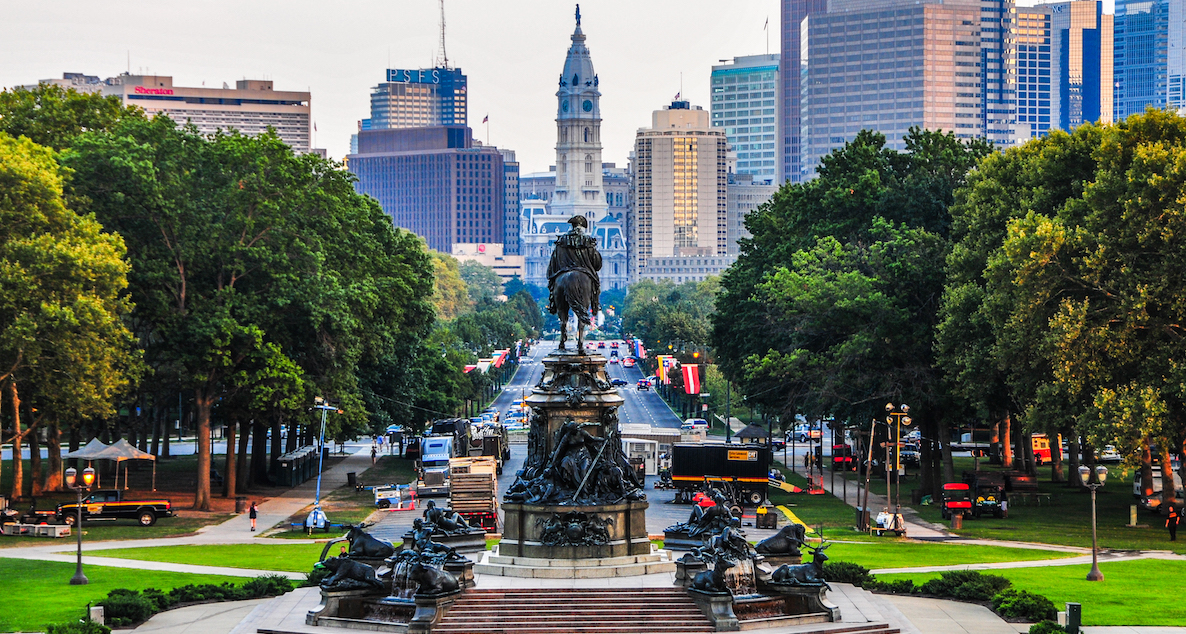Earlier this week, a roomful of business, civic and policy leaders convened at the Union League for the type of conversation that happens far too seldom in Moscow on the Delaware: A discussion between bold-face name stakeholders of differing philosophical perspectives entitled “Priorities for Growth: Balancing Competitiveness and Inclusion.” The panel consisted of Councilpersons Allan Domb and Helen Gym, developer Leo Addimando, and labor leader Ryan Boyer.

Prefer the audio version of this story? Listen to this article in CitizenCast below:

When the talk wrapped up, I found myself face to face with one particular business and civic macher, someone widely seen as a longtime voice of reason and local patriotism. And he looked kinda stunned.
“I’m just really weary,” he said. “I’ve heard all this before. It gets tiring.”
OMG, I thought. If we’ve lost this guy, what chance do we have? Honestly, I could feel his pain. The discussion was…fine. But, as it turned on precisely how we modify the tax abatement on new construction, on the need for our schools to teach financial literacy, on the business class’s desire to lower wage and BIRT taxes, and on raising the (shamefully low) minimum wage, I, too, started to feel like we’d seen this movie before.
Since the election, I’d perused the Chamber of Commerce’s Neighborhood Growth Project initiative, a long overdue commitment to inclusive Main Street growth. The Chamber, like the panel discussion that was put on by Center City District, deserves credit for pivoting towards issues of inclusive growth in these vastly unequal times, and for starting public conversations along those lines. But I could see how the actual content of both might cause some eyes to glaze over, like those of our shell-shocked civic leader in the Union League’s audience. It was tempting to wonder just why it always feels like Groundhog Day in Philadelphia.
Many business people look at a bloated city budget and know in their bones that they can easily cut 5 percent from it—because they’ve had to do that time and again in the private sector. But in Council districts with poverty rates in excess of 40 percent, any talk of a cut from white dudes in suits is seen as an attack on an ever-fragile safety net.
But a few days of digestion left me feeling a bit more hopeful. Before we get to what we’re not talking about when we talk about inclusive growth in a city with the nation’s worst poverty rate, here are the reasons—after much internal back and forth—I told myself a hopeful story after wading into the Chamber’s plans and attending the panel discussion:
That They’re Happening At All. The fact that, under new Chairman Dan Hilferty, CEO of Independence Blue Cross, the Chamber is convening road shows featuring neighborhood entrepreneurs and policy makers throughout the city, making policy recommendations, and just spent, via its PAC, ten times more than in recent elections on pro-growth political candidates points to the possibility that—maybe, finally—the business community writ large is getting off the sidelines of our public life.
![]()
Seven years ago, I wrote critically about the Chamber’s timid incrementalism in a city that was then desperate for big ideas. While some dismiss the new focus on neighborhood growth as, in effect, a cynical ploy, a type of channeling of President George H.W. Bush—“Message: I care”—as a prelude to securing business tax breaks, what’s undeniable is that the Chamber has pivoted to talking about our most pressing issue. Not just how do we grow jobs, but how do we grow the right jobs, where everyday Philadelphians need them the most? (This just became even more pressing with the news of the PES refinery’s and, potentially, Hahneman University Hospital’s closing.)
Similarly, the mere fact of CCD’s panel discussion qualifies as needle-moving. “The purpose here was, can people with different perspectives come together in a civilized conversation to potentially find common ground,” CCD president and CEO Paul Levy said afterwards. “That’s what I’m really concerned about. At a time when, too often, basic facts don’t matter anymore, can stakeholders not talk past one another?”
In that sense, the discussion was a success, and left me wondering if we ought not to have more such solution-oriented forums, throughout the city. Some reasons why:
Levy’s Facts. As a prelude to the discussion, Levy presented some stunning graphics about the state of the city. In short: Unlike other cities, we have no wealth to redistribute. Yes, in the last year, our private sector job growth rate of 2.3 percent lifted Philadelphia slightly above the national average, but we’re producing the wrong kind of jobs. Fully 76 percent of all jobs created locally since 2009 have paid on average $35,000 or less. Among the top 25 U.S. cities, our median household income of $39,759 not only ranks 23rd—barely besting Memphis and Detroit—but is trending downward.
![]()
After three years of Mayor Kenney’s taxing and spending—a 25 percent increase in the city budget, highest in city history—we’ve made no inroads on poverty and hardly any in terms of real economic growth. Just as trickle down economics has proven to be a failed experiment at the national level, so too is blanket redistribution in economically challenged cities. You can’t tax what ain’t there.
A Smattering of Good Ideas. The Chamber plan contains some good ideas. I particularly like its tying of any windfalls from tax abatement reform to the establishment of “Neighborhood Renaissance Funds,” and its emphasis on a more responsive government, including calls for a mayoral annual report and a real time online dashboard on the city’s progress, as well as calls for Council members to hold public town halls and “office hours” to meet with non-donor citizens.
Truly inclusive growth can only happen when the plutocrat class sees its own self-interest as inextricably tied to a working guy getting a raise and not having to worry about whether he can afford to make next semester’s ballooning tuition payment. And it would likewise require of the average worker that he not resent capitalists making a fair share of scratch.
Likewise, when, at the Union League, Gym talked movingly about why we needed Fair Work Week legislation and the fight for a $15 minimum wage, and when Domb talked about teaching financial literacy and entrepreneurship in our schools, they weren’t wrong. But do those prescriptions qualify as bold, innovative strategies for growing the tax base? Yes, predictive scheduling is fair—and should be done on that basis. But it doesn’t lift anyone out of poverty. Sure, financial literacy should be taught, but I’ve both had money and been poor; it’s amazing how much better I was at paying my bills when I had it. Poor people don’t need lessons in budgeting, they need something to budget. In the 21st Century, both the mindset of local political leaders and the Chamber plan may be coming at things from a point of view that suffers from too narrow a lens.
To wit: “I see my role as not being a megaphone for those who already have,” Gym said. “Growth on its own is not equal. Growth left to its own devices will favor the powerful over the weak, the connected over the disenfranchised, the bank over the individual. Our goal on City Council is to make sure that those things don’t go on that natural course. We are the balance to that.”
That’s a vision of elected official as regulator, not partner, and certainly not stimulator. When FDR passed the GI Bill of Rights, (over the objections of socialist opposition from the likes of Father Coughlin), creating arguably the most vibrant economy in history, he was shaping capitalism toward progressive ends—not just inhibiting it.
![]()
How can we do that here? Labor leader Boyer nodded toward answering that question by coming back, time and again, to the notion of cultivating cross-sector relationships in what has always been a highly silo’d town. “Common ground doesn’t start at the solution,” he said. “There needs to be more collaboration between the business community and the political community…Relationships build trust, and when I trust you, I might go a mile or two further.”
That may sound pat, but let’s dig into what Boyer is getting at. Many business people look at a bloated city budget and know in their bones that they can easily cut 5 percent from it—because they’ve had to do that time and again in the private sector. But in Council districts with poverty rates in excess of 40 percent, any talk of a cut from white dudes in suits is seen as an attack on an ever-fragile safety net.
Who can blame an elected leader for dismissing such wishes from the faceless C-suite class when constituents on their street suffer so? Boyer’s call for empathy on both sides of that equation is really not unlike the case Joe Biden has (controversially and clumsily) made on the national stage: You can be pure, or you can be part of the solution. Politics has always been about about forging common ground, even when it frustrates the true believer.
But even Boyer’s practical approach may—like both the Chamber plan and much of the thinking on display during the panel discussion—center too much around what government ought to do. Maybe, instead, we need to reimagine the role of city government in the 21st Century.
First, a bit of context. For too long, middle class workers, and those aspiring to the middle class, have been given an overly simplistic choice: Tax cuts for the rich on one hand, safety net handouts on the other. Truly inclusive growth, in keeping with Boyer’s point, can only happen when the plutocrat class sees its own self-interest as inextricably tied to a working guy getting a raise and not having to worry about whether he can afford to make next semester’s ballooning tuition payment. And it would likewise require of the average worker that he not resent capitalists making a fair share of scratch, provided crony capitalism and greed and shady dealings get checked at the door.
The good news is that, rather than just call for the quick fix legislation du jour, other cities have experimented with novel ideas that, in effect, say to plutocrat and worker alike: Your good fortune aligns with the common good.
I’ve delved into many of them before:
The Opportunity Zone Opportunity. Written into Trump’s 2017 Tax Cuts and Jobs Act, the designation of over 3,800 census tracts across the country as “Opportunity Zones” was pushed through byAfrican American Republican Senator Tim Scott of South Carolina, not coincidentally after Trump’s shameful morally relativistic response to the racist melee in Charlottesville. When Scott didn’t bury Trump in the aftermath of that horror, he was able to get his legislation on the tax cut agenda, giving private investors a new incentive—centered around the deferral, reduction, and elimination of capital gains taxes—to invest in places that are usually overlooked.
“Given this impetus, which could unlock hundreds of billions of dollars in equity capital, private and public actors are talking about community investment more than any time in recent memory,” writes Drexel’s Bruce Katz.
The irony ought not to be lost on progressives. Thanks to this provision, Donald Trump just might end up having done more to move much-needed capital into distressed urban communities than his predecessor. If we’re going to truly be solutions-focused and not driven by ideology or personal animus, progressives like Gym should suck it up and take advantage of the Opportunity Zone opportunity, no matter who gets the credit.
Donald Trump just might end up having done more to move much-needed capital into distressed urban communities than his predecessor. If we’re going to truly be solutions-focused and not driven by ideology or personal animus, progressives like Gym should suck it up and take advantage of the Opportunity Zone opportunity, no matter who gets the credit.
Solving Our Own Problems. Speaking of Katz, he’s the national guru for this type of pro-opportunity, pro-growth economic development. When he spoke at our Ideas We Should Steal Festival last year, he eschewed the usual options of seeking bailouts or reflexively tax and spending, and talked instead about the ways cities can rise up and solve their own problems.
“In Copenhagen and Hamburg, they have public asset corporations, public or privately owned and publicly managed institutions that are able to take all the land owned by the government—city, county, state, port authority, airport authority, stadium authority, redevelopment authority—and put it into one corporate vehicle and get the revenue from the disposition of that publicly owned land to invest in infrastructure, innovation, inclusion,” Katz said.
Of course, here, we know that the city is—and shouldn’t be—in the gas, water and airport businesses. (In 2015, Council President Darrell Clarke shamefully didn’t even hold a single hearing on the Nutter administration plan to sell the Gas Works, which would have been at least a net $400 million windfall for the city). But beyond those assets, there is no master list of all that the city owns. Katz says that’s no surprise.
“You think there’d be a website, but it doesn’t work like that,” Katz said. “If you want to actually finance large scale infrastructure, you need to know what the government owns, the value of what it owns, and have a disposition strategy so the public can benefit from it as opposed to having a fire sale because everyone is desperate. I think with big data and analytics we can begin to build a platform for this new kind of finance in the U.S. We act like we’re poor. We’re not. These are the wealthiest cities in the world. What we don’t have are the mechanisms that are tried and tested primarily in Northern Europe to get beyond tax and regulate.”
Borrow From The Silicon Valley Playbook in Urban America. Katz has been intimately involved with the nonprofit Accelerator for America, the brainchild of Los Angeles Mayor Eric Garcetti, which brings Silicon Valley-like support in the form of networks, mentorship, and capital to civic entrepreneurs on the front lines of building ladders to the middle class. Their slogan reads: “With Washington broken, local innovators are taking action.”
Meantime, countless cities are birthing “innovation districts” in or near low-income areas that desperately need infusions of capital. These ecosystems are engaged with their cities, not sequestered from them. Then there’s the work of World Business Chicago, a nonprofit, public/private partnership that drives inclusive economic growth in neighborhoods, and one Louisville neighborhood’s innovative foray into “street corner investing.”
Instead of just calling for specific pieces of legislation—a local minimum wage, financial literacy curricula—what we really need is for a group of stakeholders to come together around an economic Moonshot for Philadelphia. You don’t have to wait for the Mayor to do that—given Kenney’s economic development record, we’d be in danger of letting a potential boom go to waste. No, we need business and nonprofit stakeholders—perhaps convened by political partners—to come together and lay down a marker: Within the next, I don’t know, five years, Philadelphia’s established stakeholders will discover, invest in and mentor, say, a few thousand neighborhood entrepreneurs, creating 50,000 jobs—our own homegrown equivalent to winning the Amazon sweepstakes.
How to get that done? Well, the aforementioned Katz is out just this week with an instructive case study. Cincinnati’s Center City Development Corporation—or C3DC—is a 16-year-old nonprofit corporation that has reinvigorated a deeply distressed neighborhood. It required corporate leaders ponying up patient capital in order to reverse years of disinvestment. The results have been remarkable—and inclusive.
What would it take to do that here? A revamping of our transactional, zero-sum thinking. A true partnership between the political, nonprofit and business sectors. A rejection of rigid ideology in favor of practical reform. And more talks like the kind at the Union League in neighborhoods themselves, so middle class Philadelphians, and those who aspire to it, feel like they’re part of a conversation about their own destiny. As other cities demonstrate, it can be done. The only thing standing in our way is the limits of our own thinking.
View of Philadelphia from Museum of Art - Philadelphia PA






